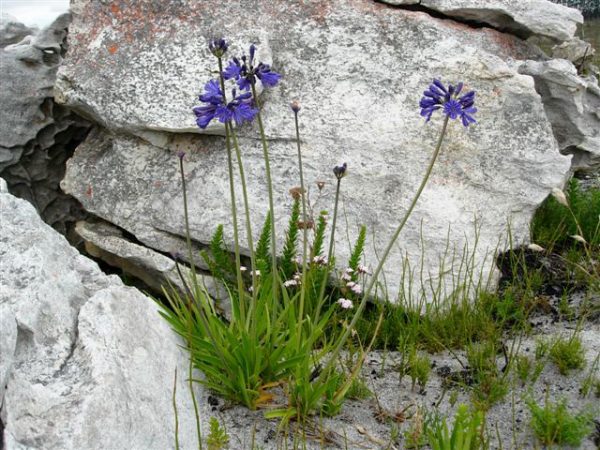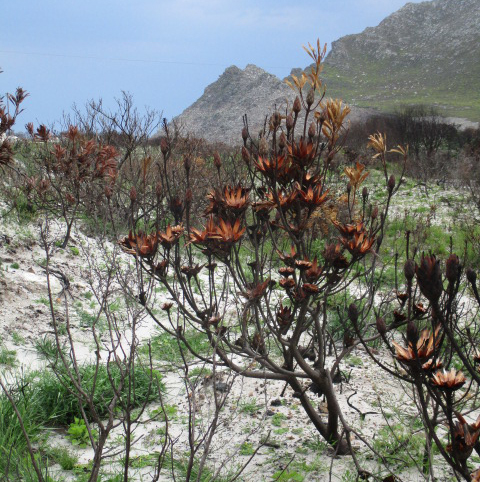
South Africa
Written on 21st February, 2018In the run up to the 2018 RHS Chelsea Flower Show, I visited South Africa on numerous occasions, researching for my Show Garden on Main Avenue, having come up with the concept for the garden on a previous holiday here. During our holiday, I kept spotting plants that we know in the UK, growing wild, in their natural habitat, and thus was born my love for botany.
First, an introduction to Fynbos, the dominant vegetation in the southwestern cape. It takes its name from the early Dutch settlers from the 19th Century, who complained of not being able to find any trees to chop down and use to build houses (“just this useless ‘fijnbosch’” – meaning ‘fine bush’). It’s a shrubby vegetation which thrives on free draining, nutrient poor, leached soils. There are about 9,000 species of flowering plants in this, by far the smallest of the six plant kingdoms. Two thirds of these species are found nowhere else on earth. And boy, do they flower!
Fynbos can be divided into 4 main growth forms; proteoid plants are woody shrubs with large leathery leaves; reed like restio plants have dispensed with leaves and have green stems for photosynthesis; ericoid plants have small leaves with margins which are rolled under to minimise water loss; and geophytes, which are plants which grow from bulbs or other underground storage organs, often after fire, of which more later.
The majority of these plants have managed to adapt to these harsh conditions and, as I said, grow nowhere else naturally in the world so the only time you’re likely to spot any of the proteoid plants outside of of South Africa is in expensive cut flower arrangements. I’m in two minds as to whether this is a good or bad thing because the flowers are remarkable, and unlike anything else in the other floral kingdoms. They deserve to be more widely appreciated, and yet when you come to South Africa, knowing that you can’t find them anywhere else in the world, it’s a very special feeling to see them growing, up close and personal.




I don’t profess to be a qualified botanist and even less so an expert on Fynbos, and while I’m often awestuck by the beauty of proteas and the likes of leucospermums, what really interests me is spotting the fynbos plants we know in the UK, growing in their natural habitat. As a career changer who started gardening at the same time as I started designing gardens, I’ve had a lot of catching up to do in terms of my plant knowledge, and I’ve found botanising a fantastic way to turbo charge my understanding of plants. If you see something you know, growing happily in the wild, you’ll have a really good idea of the conditions it thrives in, because no-one is looking after it. Study the composition of the soil, test its PH, make a note of the aspect, light levels, level of exposure, and moisture in the soil, and more. If the plant there is healthy then you know what conditions it enjoys. So much better than reading the back of a label on a plant pot (although admittedly, a bit more time consuming and expensive).
Below then, are two of the more recognisable fynbos plants that we grow in the UK, growing quite happily on their own in the South African Fynbos: Agapanthus and pelargoniums


Two more things about Fynbos worth a mention. First, it needs fire in order to survive. Sounds a bit contradictory doesn’t it? This was a brand new concept to me but I’ve since discovered that other vegetation types in the world also benefit. Fynbos however, is the best known example of a fire adapted vegetation and without regular burning (say every 15 years or so) there is evidence to suggest that fynbos would eventually just become a tangled mess of unhealthy old vegetation (via something called senescence) and eventually would be out competed by trees. The soil that fynbos grows on is fairly nutrient poor, which means that the recycling of soil nutrients is essential for fynbos survival. Fire is the motor that drives this cycle.



Thanks to dry, warm and windy conditions, combined with the extreme flammability of the dried, intricately branched shrubs and restioids, and the essential oils contained in many of the plants, it is rare to find strands of vegetation that are more than 20 years old. Fires are started by lightening strikes and rockfalls, and often by humans (more on this later, too).
Fires rejuvenate the vegetation by removing old senescent growth and recycling nutrients back into the soil. Thy also remove the choking canopy, allowing light to reach the surface of the soil.
What happens next is something that has stayed with me since I first saw those post fire landscapes, at first seemingly barren and charred. Fynbos recovers in one of three ways; plants resprout from their charred remains; seeds germinate in the freshly enriched soil, often triggered to do so by chemicals in the smoke; and geophytes and bulbs spring into life underground, safe in the knowledge that that is little or no competition at ground level. It’s a landscape unlike anything I have ever seen before and the speed with which it starts to recover, often showing signs barely a week after the fire has died out, beggars belief.


I want to end by flying the flag for conservation. Worldwide, about 10% of all plant species are rare or endangered. In the southwestern cape, where two thirds of all species are endemic, nearly one third are endangered. The biggest threat is the transformation of habitat for urban development and agriculture. If you’re a farmer trying to earn a crust, fynbos gets in the way of you growing fruit, or rooibos, or herding cattle. I remember a similar conversation I had with a farmer in Afghanistan who told me that a field of watermelon made a fraction of the income of a field of opium poppies. To the people who live there fynbos basically gets in the way and serves no use. It’s also why snow leopards have been hunted almost to extinction in northern and central asia’s high mountains, because they kill livestock. They’re in the way and a nuisance. It’s a sad reality that we humans can’t live side by side with nature sometimes.
Another threat comes in the form of non native invasive species such as the Australian wattle, hakea and eucalyptus. Fires at too frequent intervals also pose a threat to fynbos species that cannot regenerate quickly enough, and these are caused by climate change and the likes of careless individuals who throw cigarette ends out of the car windows or start campfires. Finally, the over collection of fynbos plants for traditional medicinal uses is also threatening its very survival. What does it all boil down to? As usual (in my humble opinion), too many people on this planet. Wouldn’t it be tragic if future generations weren’t able to enjoy this totally unique and beautiful vegetation because of the mistakes we are making now?
